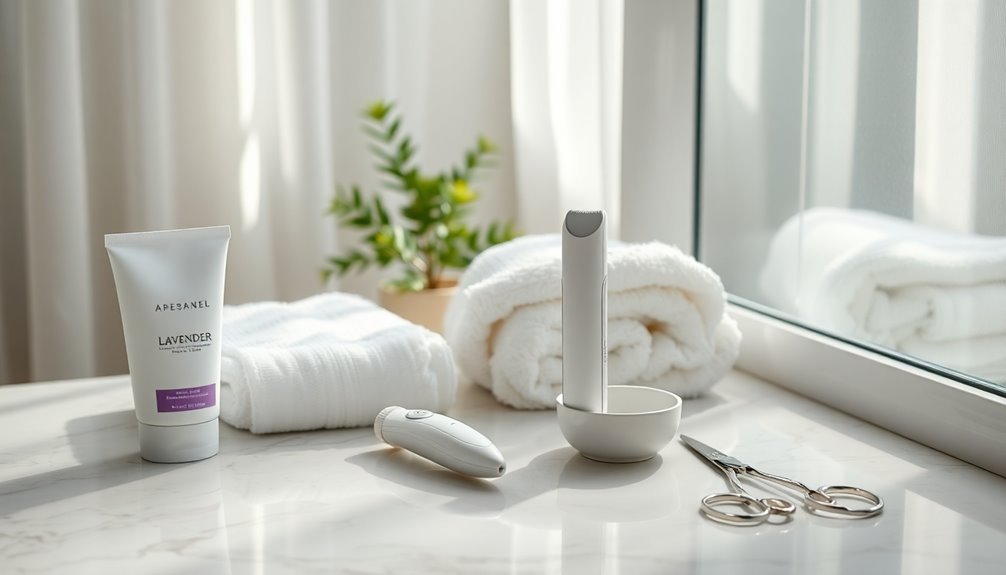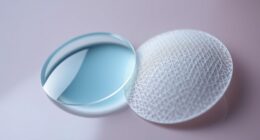To choose the right hair removal method for sensitive skin, consider options like sugaring, laser hair removal, or threading, as they're less likely to cause irritation. Always opt for hypoallergenic products and perform patch tests to check for reactions. Use a sharp razor and soothing post-treatment products if you shave. Moisturizing regularly will help maintain your skin's health. Stick around, and you'll discover more tips tailored for your sensitive skin needs.
Key Takeaways
- Assess your skin's sensitivity level and history with hair removal methods to identify suitable options.
- Opt for hypoallergenic products and techniques, such as sugaring or laser hair removal, to minimize irritation.
- Conduct patch tests before trying new hair removal products to avoid adverse reactions.
- Choose shaving cream and moisturizers specifically formulated for sensitive skin to enhance comfort during and after hair removal.
- Consult with professionals for methods like threading or laser treatments to ensure personalized care and optimal results.
Understanding Sensitive Skin
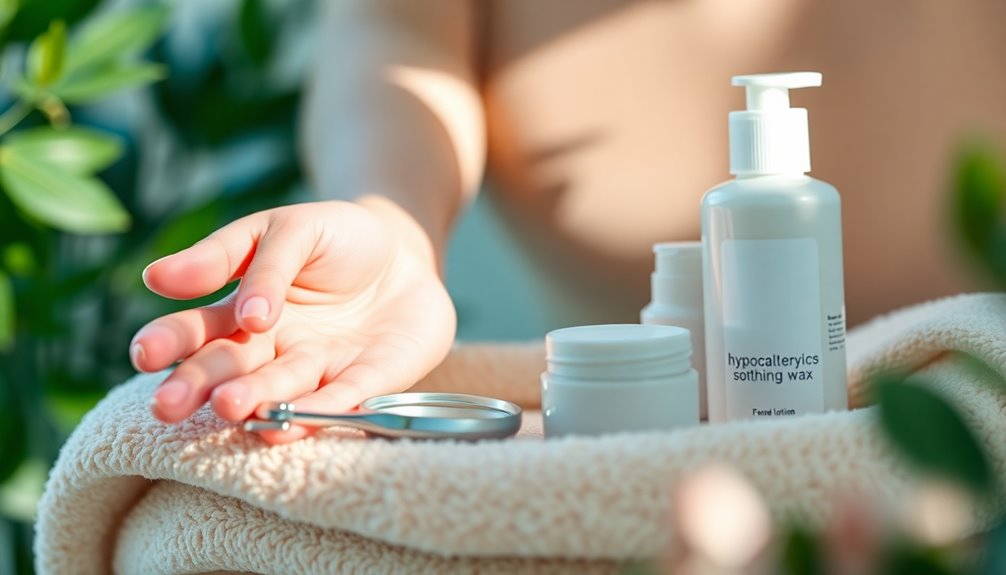
Sensitive skin can feel like a minefield, especially when it comes to hair removal. Your skin reacts strongly to various environmental factors and products, leading to irritation, redness, and discomfort.
Traditional hair removal methods can often trigger razor burns, ingrown hairs, and even allergic responses, leaving you frustrated. Conditions like eczema and psoriasis can further complicate things, increasing the risk of irritation during hair removal.
To navigate this, it's crucial to identify your skin type and sensitivity levels. This understanding helps you choose suitable hair removal techniques that minimize adverse reactions. Additionally, considering potential side effects of hair removal methods can further guide you in making a safe choice.
A consultation with a dermatologist or skincare professional can tailor your hair removal methods, prioritizing your skin's health and comfort while keeping irritation at bay.
Common Hair Removal Challenges for Sensitive Skin
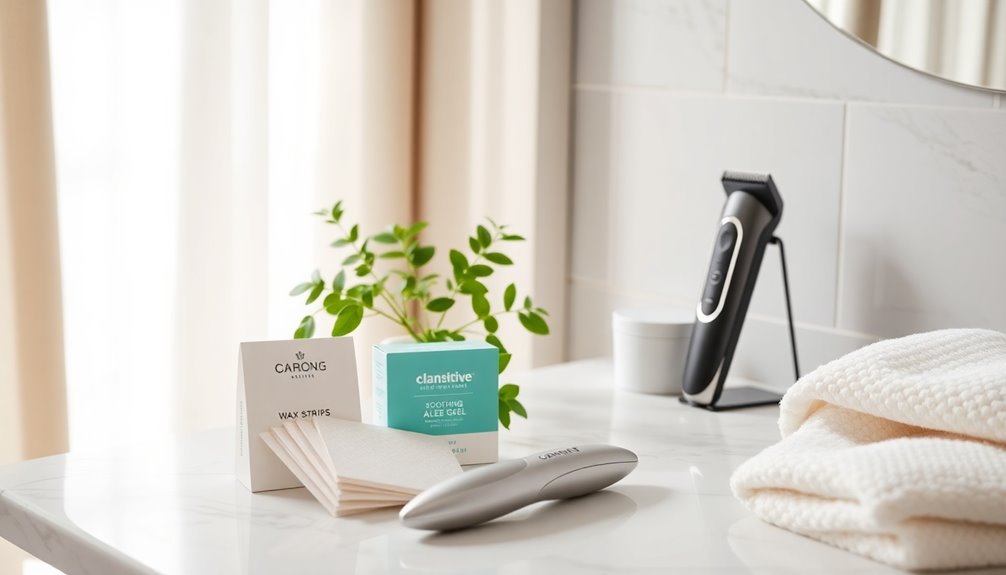
When dealing with hair removal, you may find that common methods pose unique challenges for those with sensitive skin.
Hair removal methods can create unique challenges for individuals with sensitive skin, leading to irritation and discomfort.
Conventional hair removal methods often lead to issues like razor burns, redness, and itching, increasing the risk of irritation. Techniques that pull hair from the root, such as waxing and threading, can cause ingrown hairs and inflammation, especially if you have existing skin conditions like eczema or psoriasis.
To navigate these challenges, it's crucial to choose hair removal options that are effective for sensitive skin. Always perform a patch test before trying new products or techniques to check for potential reactions. Additionally, dilution guidelines for any topical treatments can help minimize irritation when using products that may contain essential oils.
Additionally, moisturizing with hypoallergenic products post-treatment can soothe your skin and minimize irritation.
Shaving Techniques for Sensitive Skin
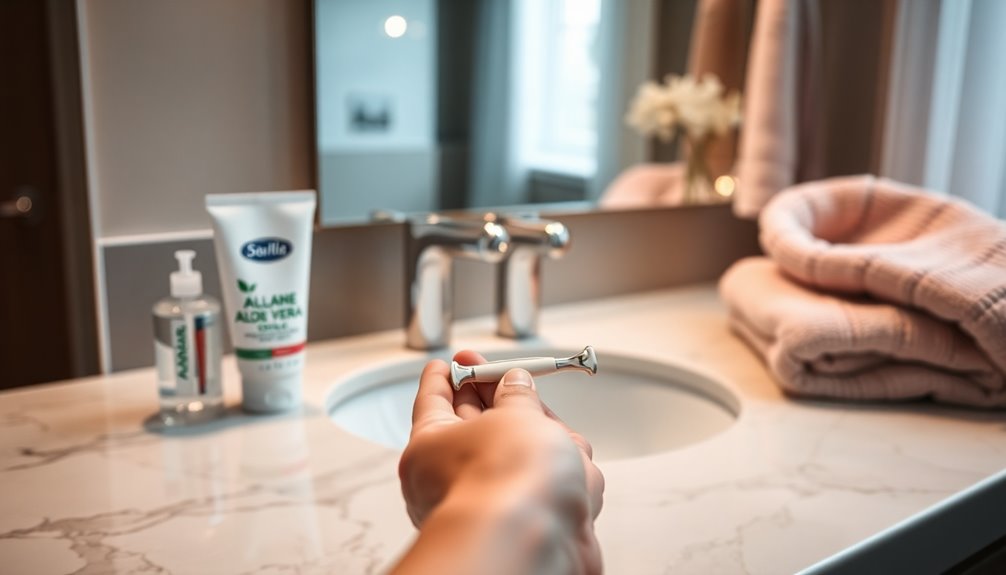
When you're shaving sensitive skin, choosing the right razor is vital for preventing irritation.
Using moisturizing products during and after your shave can make a world of difference in how your skin feels.
Incorporating essential oils for hair growth into your post-shave routine may also help soothe and nourish your skin.
Let's explore some essential techniques that can help you achieve a smoother, more comfortable shave.
Razor Selection Importance
Choosing the right razor is essential for anyone with delicate skin. Look for razors that feature built-in moisturizers and multiple blades; these can help minimize irritation and deliver a closer shave.
It's vital to regularly replace your razor to prevent dull blades, which can lead to nicks, cuts, and razor burn. When you shave, use a shaving cream specifically formulated for sensitive skin, ensuring it's free from allergens and harsh chemicals.
Always shave in the direction of hair growth to avoid ingrown hairs and reduce trauma to your skin. After shaving, focus on post-treatment care by applying a soothing aftershave balm or lotion with calming ingredients like aloe vera to alleviate any redness and irritation. Additionally, maintaining optimal air quality in your environment can also help reduce skin sensitivity and irritation.
Moisturizing Products Usage
After selecting the right razor, using the proper moisturizing products is key to achieving a comfortable shave, especially for sensitive skin.
Start by applying a hydrating shaving cream or gel that's free from fragrances and harsh chemicals. This creates a protective barrier that enhances glide and reduces irritation.
Before you shave, wet your skin with warm water to soften the hair and open your pores, which helps you achieve a smoother shave.
Remember to replace your razor regularly to maintain sharpness and cleanliness.
After shaving, soothe your skin with a calming lotion or aloe vera gel to help reduce redness and inflammation. Incorporating hydrating ingredients like hyaluronic acid into your post-shave routine can enhance moisture retention and further soothe sensitive skin.
These steps will greatly improve your shaving experience and keep your sensitive skin happy.
Post-Shave Care Tips
To keep your skin feeling comfortable and irritation-free post-shave, it's vital to apply soothing products right away. Use a soothing aftershave balm or aloe vera gel to calm irritation and hydrate your skin, helping to reduce the risk of redness and razor burn.
A fragrance-free moisturizer is also necessary for replenishing moisture and protecting your skin barrier, especially if you have sensitive skin.
For the best results, always use a sharp, clean razor with built-in moisturizers, and replace blades regularly.
Prior to shaving, exfoliate to remove dead skin cells, but avoid harsh scrubs afterward to prevent irritation.
Finally, consider using hypoallergenic shaving creams to minimize allergic reactions and guarantee a smooth glide during your shave. Incorporating products like pimple patches can also aid in targeted treatment for any blemishes that may arise post-shaving.
Waxing: Tips for Minimizing Irritation

When it comes to waxing sensitive skin, choosing the right hypoallergenic wax is essential. You should also prepare your skin properly and use soothing techniques afterward to minimize irritation. Additionally, understanding gentle methods can help in selecting the most suitable hair removal approach for your skin type. Let's explore how these tips can enhance your waxing experience.
Choose Hypoallergenic Wax
Selecting the right wax is essential for a comfortable hair removal experience, especially for those with sensitive skin. To minimize irritation, opt for hypoallergenic wax formulas that avoid harsh chemicals and fragrances. Soft wax options are your best bet, as they adhere more to the hair than the skin, reducing discomfort during waxing. Always conduct a patch test on a small area before full application to guarantee there are no adverse reactions. Additionally, using wax that contains gentle ingredients can further help soothe sensitive skin.
| Wax Type | Benefits |
|---|---|
| Hypoallergenic | Minimizes allergic reactions |
| Soft Wax | Reduces discomfort |
| No Fragrance | Limits irritation |
| Gentle Ingredients | Soothes sensitive skin |
| Patch Test | Guarantees compatibility |
Choosing wisely will keep your skin happy and irritation-free!
Pre-Wax Skin Preparation
Preparing your skin before waxing is essential for minimizing irritation and achieving the best results.
Start your pre-wax skin preparation by exfoliating 24 hours in advance. This helps remove dead skin cells and reduces the risk of ingrown hairs.
Next, cleanse the area thoroughly with a gentle, fragrance-free cleanser to eliminate oils and impurities that can interfere with wax adhesion.
After cleaning, apply a soothing lotion or oil to hydrate sensitive skin, allowing it to absorb fully before waxing.
Don't forget to conduct a patch test with the wax on a small area to check for any allergic reactions.
Finally, verify the wax is at the right temperature—too hot can burn, while too cool won't adhere properly. Additionally, butter's high fat content can be beneficial for skin hydration when used in DIY skin care products.
Post-Wax Soothing Techniques
After waxing, your skin may feel sensitive and require some extra care to promote healing and comfort.
To soothe post-wax irritation, apply aloe vera gel; it's a fantastic natural remedy that hydrates and calms your skin. You might also want to use a cold compress to reduce redness and inflammation.
Avoid hot showers, saunas, and intense workouts for at least 24 hours to minimize skin irritation. Incorporating hypoallergenic moisturizers into your routine helps maintain hydration and supports the healing process. Additionally, consider using products rich in antioxidants like quercetin to further aid skin recovery.
A few days after waxing, gently exfoliating the area can prevent ingrown hairs and keep your skin smooth.
The Benefits of Sugaring for Sensitive Skin

For those with sensitive skin, sugaring offers a gentle and effective hair removal solution. This natural method, made from sugar, lemon juice, and water, is hypoallergenic and ideal for delicate skin types.
Unlike traditional waxing, sugaring is applied at room temperature and removes hair in the direction of growth, ensuring minimal skin irritation. You'll appreciate that it effectively removes hair as short as 1/16 inch, leading to smoother skin and fewer ingrown hairs.
Sugaring treatments can last four to five weeks, providing long-lasting results while improving your skin's overall condition. Additionally, exfoliating before sugaring can enhance results and further minimize irritation, making it a perfect choice for sensitive areas.
Exploring Laser Hair Removal Options

How effective can laser hair removal be for those with sensitive skin? This method utilizes targeted laser beams to selectively damage hair follicles, making it a highly effective hair removal option.
Specialized lasers can be tailored to your skin type, ensuring safety while minimizing the risk of skin irritation. Many individuals find that after multiple sessions, they experience long-lasting results, considerably reducing the need for frequent hair removal.
Specialized lasers can be customized for your skin type, reducing irritation and delivering long-lasting hair removal results.
It's crucial to consult with a qualified professional before starting the process to assess your skin sensitivity and create a tailored treatment plan.
Post-treatment care, including calming gels, can also help soothe your skin and minimize any discomfort, making laser hair removal a viable choice for sensitive skin.
Threading and Plucking: Gentle Alternatives

While laser hair removal offers a high-tech solution for many, those with sensitive skin might appreciate gentler alternatives like threading and plucking.
Threading is an ancient technique that uses a twisted cotton thread to remove hair from the root, minimizing irritation and avoiding chemicals or heat. This makes it perfect for sensitive skin, as it shapes eyebrows and removes facial hair with minimal contact.
Plucking, though slower, works well for small areas like eyebrows if done carefully to prevent ingrown hairs or irritation.
Both methods typically cause less post-treatment inflammation than waxing or shaving, making them suitable hair removal techniques for reactive skin.
Just make certain you have threading performed by a trained professional to maximize comfort.
Depilatory Creams: What to Consider
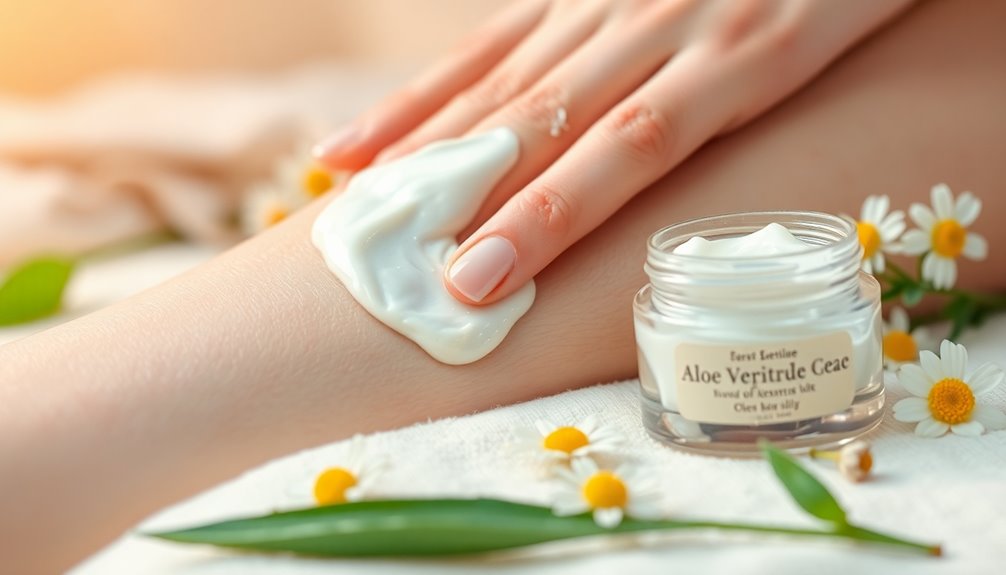
Are you tired of dealing with the discomfort of traditional hair removal methods? Depilatory creams can be a painless option for sensitive skin, but there are significant factors to take into account:
Discover a painless hair removal alternative with depilatory creams, perfect for sensitive skin when used carefully.
- Patch Test: Always do a patch test 24 hours before using a new depilatory cream. This checks for allergic reactions and minimizes irritation.
- Application: Apply the cream only on clean, unbroken skin. Following the manufacturer's instructions is essential to prevent chemical burns.
- Formulation: Choose depilatory creams specifically designed for sensitive skin to reduce the risk of irritation and achieve a gentler hair removal experience.
Professional vs. At-Home Hair Removal Methods
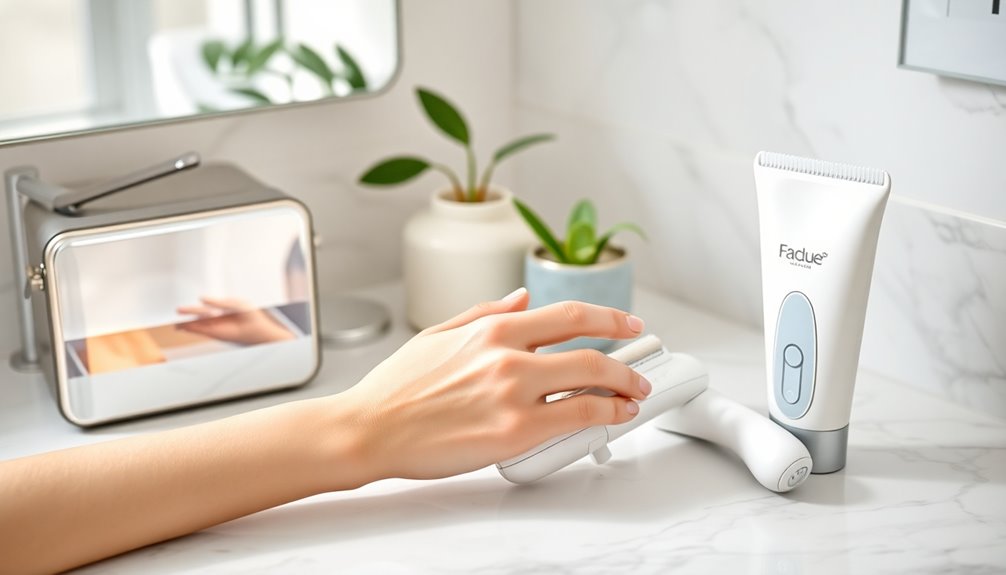
When it comes to choosing between professional and at-home hair removal methods, what factors should you consider for sensitive skin?
| Professional Methods | At-Home Options |
|---|---|
| Tailored for sensitive skin | Convenience and cost-effective |
| Reduced irritation risk | Potential for allergic reactions |
| Long-lasting results | Higher risk of complications |
Professional hair removal methods, like laser and specialized waxing, greatly minimize irritation and provide personalized assessments. They often yield long-lasting results with less hair regrowth. On the other hand, at-home hair removal options, such as shaving or depilatory creams, might seem easier but require careful product selection to avoid discomfort. If you have sensitive skin, weighing these factors will help you make the best choice for your needs.
Frequently Asked Questions
What Is the Best Hair Removal Technique for Sensitive Skin?
When it comes to hair removal for sensitive skin, you've got a few great options.
Laser hair removal's often your best bet since it targets hair follicles with less discomfort.
If you prefer something more natural, try sugaring—it's gentle and reduces the risk of irritation.
For delicate areas like your eyebrows, threading minimizes skin contact.
If you opt for waxing, just make sure to choose hypoallergenic products and a skilled technician.
What Is the Best Hair Removal for Sensitive Skin?
When it comes to hair removal for sensitive skin, you might be wondering what'll work best without causing irritation.
You've got options like laser hair removal, which offers long-lasting results, or the gentle touch of sugaring.
Then there's threading, perfect for precise areas. Waxing can work too, but you'll need hypoallergenic products.
Always remember to consult with a professional and test before diving in, ensuring your choice won't leave you red and irritated.
What Is the Gentlest Method of Hair Removal?
If you're looking for the gentlest method of hair removal, consider sugaring or threading.
Sugaring uses a natural paste that minimizes skin irritation, while threading offers precision and is gentle on sensitive areas like your face.
Laser hair removal is another great option, as it targets hair follicles without causing much irritation.
If you prefer a cream, verify you patch test depilatory creams to avoid adverse reactions.
Choose what suits you best!
How to Remove Hair Down There for Sensitive Skin?
To remove hair down there with sensitive skin, you've got several gentle options.
Sugar waxing's a great choice; it minimizes irritation and pulls hair in the direction of growth.
If you prefer shaving, use a razor with moisturizers and a sensitive-skin shaving cream to avoid razor burn.
Threading's another option that offers precision without much skin contact.
Always do a patch test first to guarantee your skin doesn't react negatively.
Conclusion
Maneuvering the world of hair removal with sensitive skin can feel like walking through a minefield. By understanding your skin's unique needs and trying out different methods, you can discover the perfect fit—much like finding the right key to access a treasure chest. Whether you choose shaving, waxing, or a gentler option like sugaring, remember that your comfort is the ultimate goal. Embrace the journey, and soon you'll reveal a routine that leaves your skin feeling smooth and happy.
